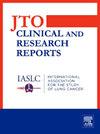Real-World Validity of Tissue-Agnostic Circulating Tumor DNA Response Monitoring in Lung Cancers Treated With Chemotherapy, Immunotherapy, or Targeted Agents
IF 3.5
Q2 ONCOLOGY
引用次数: 0
Abstract
Introduction
Circulating tumor DNA (ctDNA) monitoring is emerging as a minimally invasive complement to tumor imaging. We evaluated the validity of tissue-agnostic ctDNA quantification across four treatment modalities in NSCLC and SCLC.
Methods
Data from consenting patients were collected from electronic health records as part of the Prospective Clinico-Genomic study (NCT04180176). ctDNA tumor fraction (TF) was retrospectively calculated for plasma collected six to 15 weeks after therapy initiation. TF dynamics were compared among an exploratory cohort, NSCLC and SCLC validity cohorts, and by therapy class.
Results
In on-treatment plasma, undetectable TF was associated with longer real-world progression-free survival and real-world overall survival in exploratory (21.8 versus 8.8 mo; hazard ratio [HR] = 0.35, 95% confidence interval [CI]: 0.24–0.50), validity NSCLC (23.5 versus 9.5 mo; HR = 0.34, 95% CI: 0.22–0.53), and validity SCLC (15.9 versus 8.3 mo; HR = 0.19, 95% CI: 0.08–0.42) cohorts. Equal to or greater than 90% and equal to or greater than 50% TF reduction from baseline was also associated with significantly improved outcomes. ctDNA dynamics differed by treatment class: TF reported greater discriminatory power for selecting tumor responses to immunotherapy and targeted therapy (≥50% decrease in 91% of responders versus 24% of nonresponders) than chemotherapy and chemo-immunotherapy (86% versus 60%). TF dynamics correlated with outcomes, but models of real-world progression-free survival and real-world overall survival were improved when tumor response was included.
Conclusions
Tissue-agnostic monitoring of molecular response on the basis of ctDNA TF dynamics has utility in the real-world setting across four different treatment regimens. These results suggest that ctDNA dynamics may be complementary to tumor imaging in both NSCLC and SCLC to better inform patient care.
在接受化疗、免疫治疗或靶向药物治疗的肺癌中,组织不可知循环肿瘤DNA反应监测的真实有效性
循环肿瘤DNA (ctDNA)监测正在成为肿瘤成像的一种微创补充。我们评估了在非小细胞肺癌和小细胞肺癌的四种治疗方式中组织无关的ctDNA量化的有效性。方法作为前瞻性临床基因组研究(NCT04180176)的一部分,从电子健康记录中收集同意患者的数据。回顾性计算治疗开始后6至15周收集的血浆ctDNA肿瘤分数(TF)。在探索性队列、NSCLC和SCLC有效性队列以及治疗班级之间比较TF动态。结果在治疗血浆中,未检测到的TF与探索性患者更长的真实无进展生存期和真实总生存期相关(21.8个月对8.8个月;风险比[HR] = 0.35, 95%可信区间[CI]: 0.24-0.50), NSCLC的有效性(23.5 vs 9.5;HR = 0.34, 95% CI: 0.22-0.53),效度SCLC (15.9 vs 8.3个月;HR = 0.19, 95% CI: 0.08-0.42)。与基线相比,TF减少等于或大于90%,等于或大于50%也与显著改善的结果相关。ctDNA动力学因治疗类别而异:TF报告在选择肿瘤对免疫治疗和靶向治疗的反应(91%的应答者减少≥50%,24%的无应答者减少)比化疗和化疗免疫治疗(86%对60%)具有更大的区别性。TF动力学与结果相关,但当肿瘤反应纳入时,真实世界无进展生存和真实世界总生存模型得到改善。结论基于ctDNA TF动力学的分子反应的组织不可知监测在四种不同治疗方案的现实环境中具有实用价值。这些结果表明,ctDNA动态可能是对NSCLC和SCLC肿瘤成像的补充,以更好地告知患者护理。
本文章由计算机程序翻译,如有差异,请以英文原文为准。
求助全文
约1分钟内获得全文
求助全文
来源期刊

JTO Clinical and Research Reports
Medicine-Oncology
CiteScore
4.20
自引率
0.00%
发文量
145
审稿时长
19 weeks
 求助内容:
求助内容: 应助结果提醒方式:
应助结果提醒方式:


